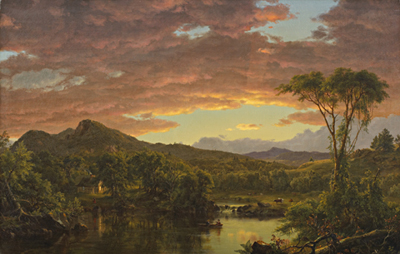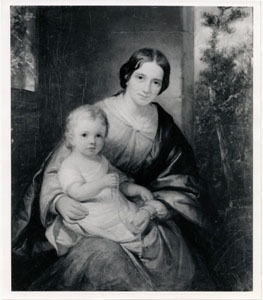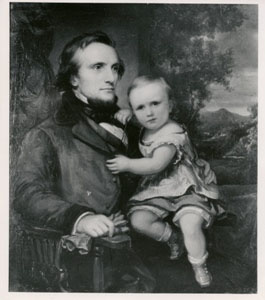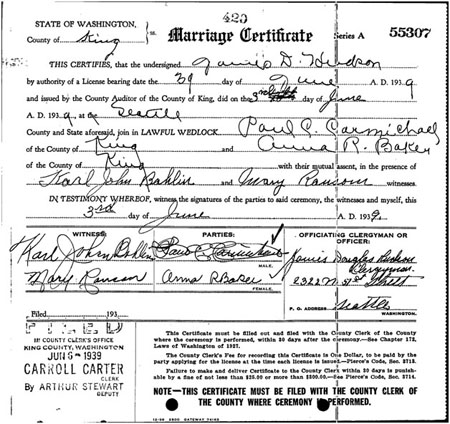The History in Art History, Part II: How This Painting Came to Seattle!
Recently I blogged about the scant history of the museum’s magnificent painting by Frederic Church, entitled A Country Home, which was a gift to the museum in 1965 from one Mrs. Paul C. Carmichael. For five years I’ve been wanting to learn more about Mrs. Carmichael and how she came to Seattle and how she came to bring with her her great grandfather’s impressive picture by Church. I’ve been surprisingly lucky in research so many times that I’m now convinced that some strange forces guide our hands as we delve into the past—forces that make sure that lives are never forgotten. The forces directed me to Mrs. Carmichael just last week.

Frederic Edwin Church (American, 1826-1900), A Country Home, 1854; oil on canvas 32 x 51 in. Gift of Mrs. Paul C. Carmichael, 65.80
I’ve been looking into the histories of an odd selection of American paintings that we have in storage. Among them is a pair of portraits by the once eminent Daniel Huntington, leader of the New York art establishment for decades in the 19th century and portraitist to the rich, famous, and powerful. Today it’s hard to appreciate the appeal of his highly conventional portrayals, but those who wished to have their likenesses preserved for posterity got a good recorder in Daniel Huntington. He painted large group portraits on occasion—one painting gathered together the faces of all the men involved in the laying of the Trans-Atlantic telegraph cable, for instance—and he painted small “cabinet” pictures, he called them, in addition to easel size portraits of eminent Victorians, numbering in the hundreds. The museum has two small “cabinet” portraits that have been in the collection since 1965. They don’t rank among Huntington’s best or most ambitious works, and haven’t been exhibited much. They have condition problems. The pair—husband and wife—no longer have matching frames, so that they seem almost like unrelated works rather than the pendant portraits that they are believed to be. I’ve been dismissive of these portraits, and I missed something key that they could tell me about the Church painting.
I’ve spent a lot of time studying the life of General Joseph Gardner Swift, original owner of the Church canvas, and I can recount from memory many of the details: I know, for instance, that he was a friend (and I believe a close relative) of portraitist Huntington, and commissioned from Huntington a cabinet portrait of himself and his wife, Louisa. I also know from reading his will that Gen. Swift bequeathed all of his pictures to his son-in-law Peter Richards, who married both of the General’s daughters, as it turns out: having lost his first wife, named Louisa after her mother, to an undisclosed illness, Richards simply married her younger sister, Sarah, sometime after. Thus, he always remained near and dear to the General’s heart.

Cabinet portrait of Louisa Richards by Daniel Huntington in the SAM collection.
When I revisited the Huntington portraits again this week, I noticed for the first time that the subjects were named as Peter Richards and his wife, Louisa. I wondered to myself, almost breathlessly, “my heavens, could there be a connection between this Peter Richards and the owner of our Church painting?” But, how could this be, when the Huntington portraits of Richards and his wife came to SAM from another source entirely and not from Mrs. Paul C. Carmichael, as the Church painting had?

Cabinet Portrait of Peter Richards by Daniel Huntington in the SAM collection.
Well, lo and behold, brief notes in the accession records, and my follow up work into marriage and death records, established that this Peter Richards in Huntington’s portrait WAS the owner of the Church landscape! And through other records, I was able to determine that two of his grandchildren came to Seattle sometime before 1910. One of these children, daughter Frances Richards Baker, her married name, was the mother of the woman who became Mrs. Paul Carmichael. The other was a son, Paul, who founded the Lion Varnish Company in Seattle and built an elegant home in Mount Baker, one of the first in the neighborhood. It was Paul who owned the Huntington portraits of Peter and Louisa Richards, which came to the museum from one of his six children.

Marriage certificate for Anna Richards Baker and Paul C. Carmichael
Washington State marriage certificates are available online. I found the one for Anna Richards Baker and Paul C. Carmichael. They were married in Seattle on June 3rd, 1939, when Anna was 39 or 40 and her new husband was 42. Mr. Carmichael had lovely penmanship, we can see, signing with elegant flourishes: a proud man on that happy day. I believe that the Karl John Bohlin who signed his name as a witness, probably as a friend of the groom, was a member of the U.S. Olympic Nordic Ski Team. There’s a story there, in their friendship, for sure.
I’ve always imagined that the owner of the Church painting was surely someone of significant means who hung the painting in luxurious surroundings, but that seems not to have been the case with Mr. and Mrs. Carmichael. Seattle city directories tell us much about their social and economic status. Mr. Carmichael was a salesman living with his parents until he married Anna Baker. She worked for the United Pacific Insurance Company, first as a receptionist and later as a bookkeeper and clerk—she retired from the company in 1965, coincidentally the year she gave the Church painting to SAM. Paul Carmichael, a veteran of the First World War, enlisted again in the army in 1940. When he returned home at the war’s end, he began a career as a clerk at the Washington State Liquor Control Board, and the Carmichaels bought a house, a modest 1200 square foot bungalow at 5233 36th Avenue N.E. that was built in 1938. Because they had no children, this small house suited their needs, and Mrs. Carmichael lived there to the end of her life—she died in 1975, having survived her husband by twelve years. The large and beautiful Church painting, which always retained its original, highly ornate frame, must have been the centerpiece of their small living or dining room.
Is it pure coincidence that Mrs. Carmichael presented the Church painting to SAM only weeks after her cousin gave the Huntington portraits of her great-grandfather to the museum? I located a living relative now in San Diego—he seems to feel that it was so, that his branch of the family never knew about Mrs. Carmichael and her Church painting. But some force made sure that these family heirlooms would be reunited in the museum after being separated for generations—and that the memory of the unassuming Mrs. Carmichael would live on through her extraordinarily generous gift to the city of one of the great works of American art. I am glad that at last I can acknowledge her and pay her this tribute.
Patricia Junker, the Ann M. Barwick Curator of American Art, Seattle Art Museum